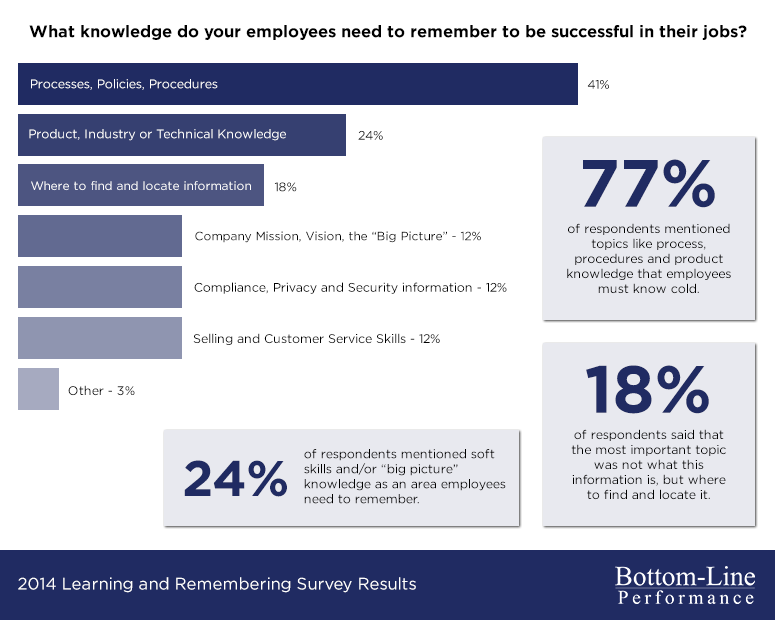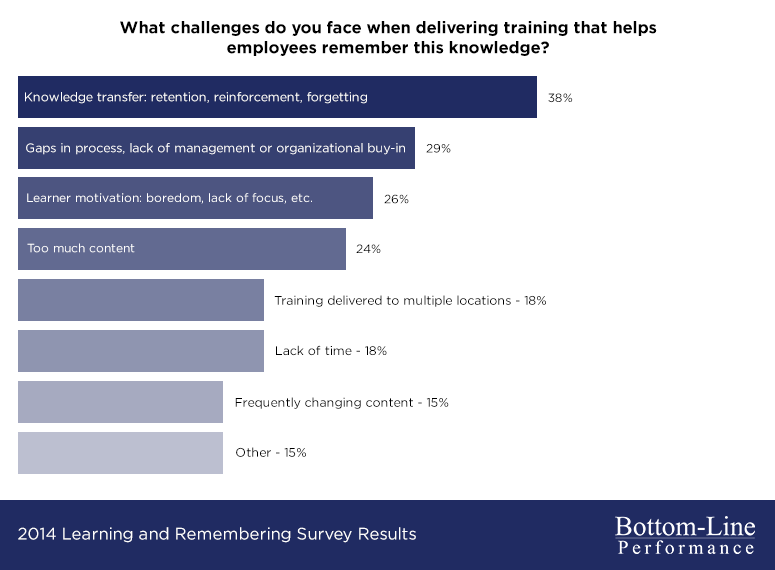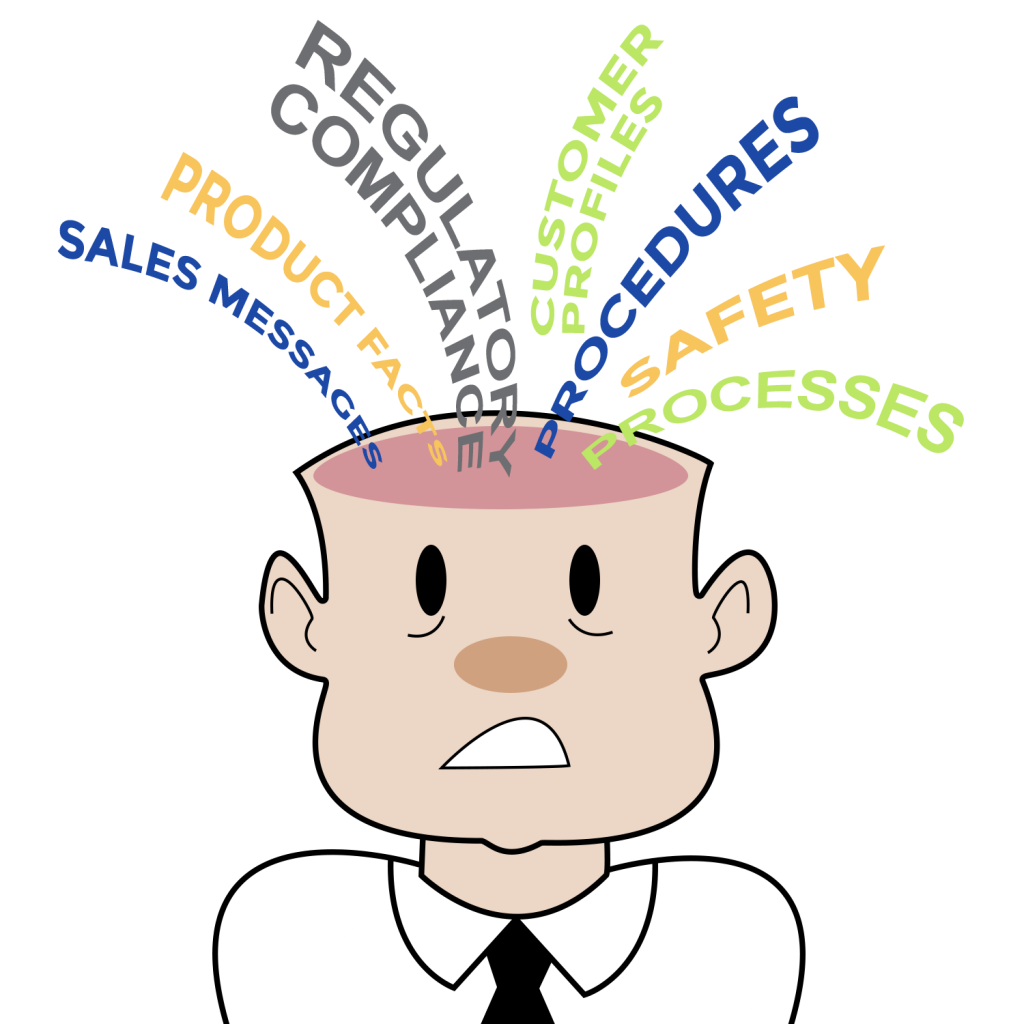
We received a variety of thoughtful responses to our two-question survey on learning and remembering. Their was a wide diversity in respondents: 34 individuals from 21 different industries participated.
The results provide a snapshot of the type of knowledge employees need to remember most to be effective in their jobs… and the challenges that make it difficult to train them on this knowledge.
![]()
| Manufacturing | Medical Device and Diagnostics | Biotech | Pharma | Defense | Agricultural Supplies | Higher Education |
| Food | Security & Investigations | Banking | Health & Beauty | Web Hosting | eLearning | Healthcare |
| Life Science | Business Software | Government | Industrial Products | Car rental | Information Technology | Automotive |
|
Total Respondents: 34
|
||||||
What do employees need to remember?
The first question of our survey asked: What knowledge do your employees need to remember to be successful in their jobs?
Responses were heavily focused on fact-based knowledge. 77% of respondents mentioned topics like process, procedures and product knowledge that employees must know cold. 18% of respondents said that the most important topic was not what this information is, but where to find and locate it.
Only 24% of respondents mentioned soft skills and/or “big picture” knowledge as an area employees need to remember.

Selected Survey Responses:
| Any information that must be recalled within a short timeframe, needed to make decision that could have substantial negative consequences or is used frequently. |
| Product and service knowledge: features and benefits and procedural details |
| Process for working across many business units. Communication protocols, how to leverage resources |
| Product, customers, competition knowledge. Articulate value prop and how it connects to customer needs and competition |
| Specific facts, figures, vocab and ideas… what they are, how it fits into their experience and how to apply that knowledge in real world settings to impact their jobs |
| Where to find information needed on the job |
| Sales people: basic understanding of market forces, product knowledge, sales and ordering proces |
| Company mission, vision and values |
| Compliance: AGSL, ACL, Privacy Act, Anti Money Laundering |
| Customer service skills, sales skills and founding values of company |
What Makes it hard for employees to remember?
We also asked: What challenges do you face when delivering training that helps employees remember this knowledge?
Keep in mind that each respondent was not asked to list every challenge they face. The question was open-ended, so some listed a single challenge and others listed two or three interconnected challenges.
Since fact-based knowledge is seen by respondents as important to remember, it’s no surprise that knowledge transfer and retention (38%) is the number one challenge faced when delivering training on these topics. Lack of buy-in and process gaps (29%) also poses a major challenge, which suggests that many L&D professionals have great ideas for how to improve knowledge transfer, but can not get buy-in from their organizations.
To make matters worse, 26% of respondents noted how learners are not motivated by current training approaches.
Another issue is the volume of ever-changing content in organizations. 24% of respondents rated “too much content” as a big challenge, while 15% cited the ever-changing nature of their content as an obstacle.

Selected Survey Responses:
| Reinforcement is difficult because there are multiple locations, follow-up dependent on the local location |
| Forgetting happens quick; training thought of as insignificant to job |
| Determining what needs to be known “cold” vs find and locate. |
| Managers not willing to pull employees off the phone, limiting training to job aids and one on ones |
| Gap between managers perceptions and what’s actually happening on the floor |
| Learners too distracted to concentrate on training |
| Employees don’t see value of training: can’t find the return on investment of their time and energy and how it impacts their results |
| Call centers creating ineffective training without talking to trainers |
| Lack of time to put together training with high detail incorporated well |
| Too many nuances of different product markets to communicate in training solutions |
| Ever changing scope and location of resources |
Takeaways
Most survey respondents believe that essential process, procedural and product information is highly important for employees to remember. This is the information that truly must be embedded into memory for employees to improve their performance.
The questions we asked were open-ended, and there certainly are other important areas of knowledge for employees to remember, but it can be argued that this practical, “nuts and bolts” type of information is what really makes a day-to-day impact on the job. What are the features of Product A? What are the steps to Process B?

If we use the challenges shared by respondents to paint a bigger picture, we start to see what is likely a familiar scenario for your organization: A large volume of content changes frequently… and learners have difficulty retaining and applying this content on the job. They are unmotivated from the current training approaches, yet managers and stakeholders in the organization do not buy in to changing or improving the existing training.
Organizations that want their L&D initiatives to have a real impact in 2015 should reflect on these challenge areas… and ways to overcome them.




